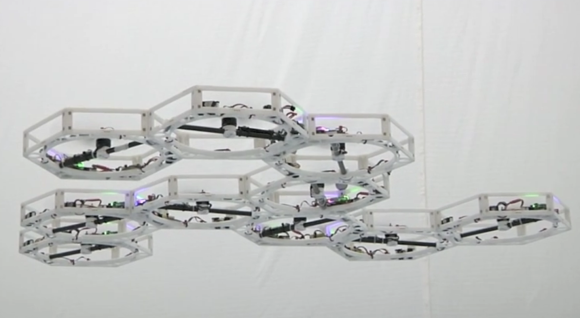
A single cell of this distributed flight system can spin its propeller but it comes at the cost of the chassis flying out of control. To realize any type of stable flight it must seek a partnership with other cells. The more astute reader will be wondering how it can autonomously pair if incapable of controlled solo flight? The designers of the project thought of that, and gave each frame a way to propel itself on the ground.
Along the bottom rails of each cage there are several small knobby wheels. These seem to function similar to omniwheels since they are not aligned in parallel to each other. Pairing is accomplished mechanically by magnets, also helping to align the pogo-pins which connect the cells electronically.
Flight tests are shown in the video below. The array can be oriented in symmetrical or asymmetrical patterns and still work just fine. If they have 3D camera feedback they can hold position and navigate quite accurately. But this can also be piloted by remote control in the absence of such a feedback system.
[Thanks Mike]















Awesome, I suppose you could use electromagnets to connect the individual pieces to allow for failed sections to be ejected during flight or even set it up so that you’d have payload modules and fuel modules then you could make a devices that can stay aloft for a very long period of time, especially if you can build them with solar panels.
Electro-permanent magnets! http://en.wikipedia.org/wiki/Electro-permanent_magnet
Maybe a variation of it. You’d only need to “turn off” the magnet very briefly to detach a cell, rather than for an indefinite period of time. So no need to have the re-magnetizable soft iron component, dump it to save weight. The electromagnet can be powered as long as field cancellation is required. But it could just as easily be in the form of a mechanical actuator, such as a solenoid to push a cell off instead.
That is an amazing project. Well done! I wish I could have been a part of that project.
Now make a flying swastika!
Quite possibly why they made them hexagons and not squares, it’s impossible. Or maybe they did that for some other reason. They’ve managed a Triskele in the photo, some idiot boneheads like that one.
I wonder what the minimum number of connected modules can be and still have stable flight. My guess is 3.
Four. Google “Tricopter”. These things have a servo tilting the third prop to compensate for yaw. A tricopter without such a mechanism would spin on the horizontal plane, opposite to the direction of it’s third prop.
Do half have clockwise rotors and half counterclockwise? Can they somehow spi either direction?
Since each propeller is autonomous, implies that each section can be gas engines instead of electric motors, thus giving longer flight time and allow for heavy payloads. Lose the magnets. Make one solid frame and forget about the novelty of having them join and then break apart. What these guys have done is very inspiring.
It looks like the whole point was to make autonomous pods work together, though!
I think this can be called a ‘what ever copter’. Coll stuff.
Skynet has been waiting for this development.
Looks like a neat little gadget.